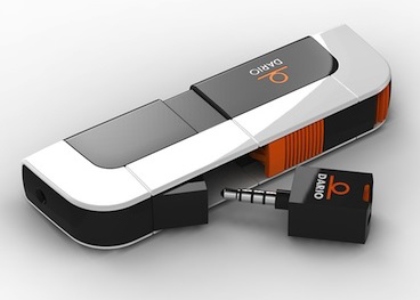Seizing The Connected Medical Device Opportunity

By Todd Durniak, LabStyle Innovations
Devices are finally talking… and they have a lot to say. After decades of silently performing their duties, saving lives, and improving quality of life, medical devices are going live via mobile technology. Repositories of important data that were often lost, or stored away until synced, are now living in the cloud, enabled in part by the ubiquity of smartphone technology and wireless networks. We are seeing a revolution in the palms of our hands.
Steps per day, body weight, blood pressure, heart rate, and blood sugar levels are just a few of the medical measurements making the leap to real-time, actionable data via applications linked to devices. This is really just the beginning. As mobile applications become central to the function of new devices, they are becoming an integral part of devices’ early development process — not just a bolt-on post launch. This will lead to next-generation devices with seamless integration into other devices, data analysis, and more informed physician decision-making. Until then, device makers and software developers are engaged in a great deal of discovery as their worlds begin to overlap. It’s not just telemedicine anymore.
The mobile health world of today is divided between sensors, mobile apps, aggregators, and big data analytics. Sensors are the oldest and most established segment of the industry, having been around since the first electrocardiogram (EKG) drove a pen on a paper roll. We now have heart rate monitors on our wrists and blood glucose analysis at our fingertips — and under our skin — all feeding directly into applications. Sensors are smaller, more accurate, and more user-friendly than ever. Today’s activity trackers, blood glucose monitors, and other connected devices generate data that is ready to be recorded and aggregated with data from other devices to create an amazingly clear picture of a user’s medical condition.
Diabetes Management Is Just The Beginning
With well-characterized treatment algorithms requiring multiple blood glucose testing events every day, the diabetes space is fertile ground for device/data/mobile integration. People with diabetes need to minimize the burden of managing a chronic condition that generates a great deal of data, including carbohydrate intake, insulin calculations, blood glucose levels, time of day, and activity level, all in an effort to maintain a normal, healthy life.
Devices have been a part of that life since the advent of the blood glucose meter. Now, with insulin pumps, continuous glucose monitors (CGM), and (eventually) closed-loop “artificial pancreas” devices, the amount of data generated every day is ever growing.

Integrate Software And Device Design (Or Be Left Behind)
Following this paradigm shift in the connected mobile health/device world, LabStyle approaches all of its product development with complete integration between the device and software application teams. Born of equal parts device and software expertise, the application is no longer a bolt-on to an existing device, but an integral part of it. This compatibility assured, the focus can center around the user’s interaction with the device/application combination to create a unique and “sticky” experience.
Usability becomes much broader when device and application are not considered separately. Upgrades become a software-driven exercise, incorporating user feedback into rapid iterations and allowing for lower costs while expanding device functionality. The user now sees a new product in every software release, keeping the relationship fresh while utilizing existing hardware. Additionally, caregivers and health care professionals receive a high-resolution picture of their patient’s progress.
While serving the individual user, connected health expands reach for all involved in that user’s care by breaking down the barriers to data access. Once a device is generating and syncing data to a cloud server, a wide range of possibilities emerges for data analysis, opening up new ways to interact with payors, clinics, and research institutions. Data that once had to be entered manually, via paper or web form, is available in real time. Health plans that utilize data to assist members on an individual basis can expand their capabilities to cover wider populations.
Coupled with demographic data and predictive analytics, this new level of visibility has the potential to improve the health of underserved and at-risk populations globally. Device makers can upload their data to data aggregation services, such as Validic and Tactio, to give their customers access to a fuller picture of their own health, across a number of devices. Data security and opt-in for sharing that data also are critical considerations in the design process.
Conclusions
The advent of connected devices is opening up a new universe of possibilities for all device developers. Unfortunately, not every organization has the luxury of starting from scratch with an integrated device/software product development process. But, where convergent evolution has leveled the playing field between competitors, a move into mobile health as an extension of an existing product can provide a fresh method of differentiation.
Exploring ways to connect your new or existing products breaks down walls between the software and hardware worlds. Innovators are working beyond these barriers to usher in a new era of connected medicine. To make the most of the opportunities in this new world, start development projects with connectivity and data security in mind; you will deliver a greater level of customer interaction and a wider array of future options for line extension.
About The Author
Todd Durniak has been Senior VP and GM for the U.S.A at LabStyle Innovations Corp. since July 2015. Mr. Durniak joined LabStyle after serving as VP and GM of Neighborhood Diabetes, a division of Insulet. Prior to that, he held a number of positions, with increasing responsibility, over seven years at Smith & Nephew Orthopedics, most recently as president of Asia Pacific, based in Sydney, Australia. Mr. Durniak began his career in engineering with Johnson & Johnson Orthopedics, leaving J&J to start and manage Texas Direct Medical, an orthopedic product distributorship. He re-joined J&J after its DePuy acquisition, advancing through a series of positions before joining Guidant, just prior to its acquisition by Boston Scientific. Mr. Durniak holds a BS in biomedical engineering from the University of Vermont and an MBA from Boston University.
